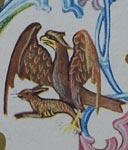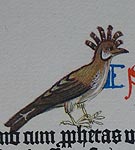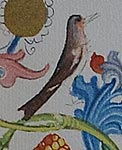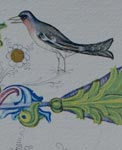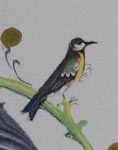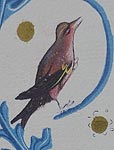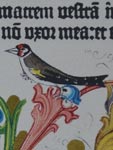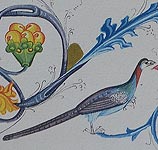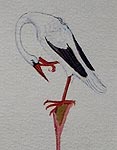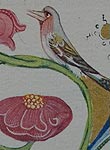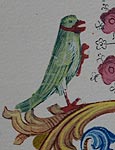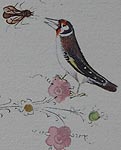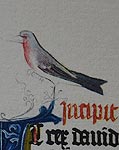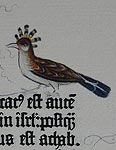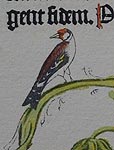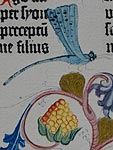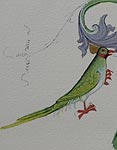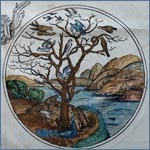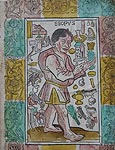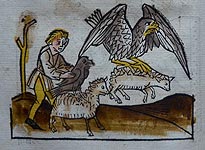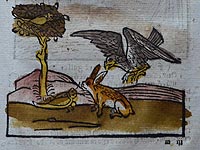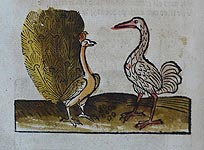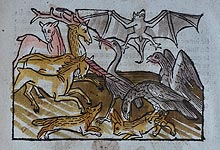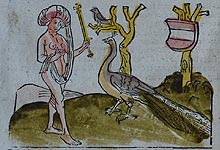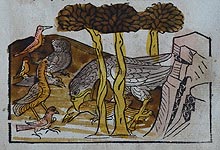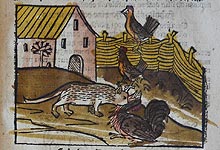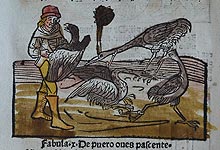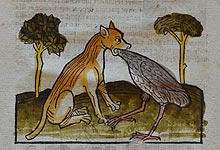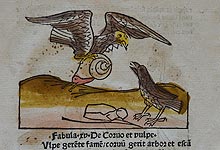Birds Images in Incunabula
- From Aesop to the Bible
- Philosophical Fables
When did people first become interested in birds? To understand this, we need to look at one of the richest sources — books. Let's search for birds in our early printed books collection.
The Gutenberg Bible was the first book to be printed in Europe. It already contains images of a wide variety of birds. These pictures were painted in by hand by different artists. Our library has no original copy of the Gutenberg Bible, but possesses its excellent large-format facsimile copy, released in 1913-1914 by the Berlin publisher «The Island» («Der Insel Verlag»).
Its ornamental decoration includes more than thirty images of birds. Many of them are depicted very realistic: a hoopoe, a parrot, a crane, a hen, a woodpecker, an eagle can be easily recognized. Some birds are shown smaller than they are. For example, one birdie has the same size as a fly. An eagle clutching a rabbit is found three times in the book. A fox grabbing a chicken is shown once.
The 15th century historical books and Bibles are often decorated with illustrations of the six days of creation, including the fifth day when God made the birds and fish.
Artists often depicted a tree without leaves (to make it easier to see birds on the branches). An engraving with a similar plot from the Chronicles of Schedel of 1493 depicts a few species of birds: an owl, a goose, a partridge, a falcon and a peacock. Some birds are shown schematically.During the 15th century, pictures of birds are repeatedly found in publications of those literary works, in which recognizable members of the human community appear in the images of the birds. Species of depicted characters-birds are different: among them are hens and geese, peacocks and cranes, hawks and eagles… For instance, we can see a lot of birds in the pages of the book «Aesop's Fables» (Aesopus. Vita et Fabulae. Strasbourg, 1481).
The collection of Aesop's fables was already known at the end of the fifth century in Athens, children in school learned the words of Aesop. 'You are ignorant and lazy, and have never read your Aesop' - says one of the personages in the comedy of Aristophanes. After the invention of the printing press, the book of fables published many times in different cities. Interest in Aesop's Fables extended to his personality: he was portrayed as a hooked, lame person, with the face of a monkey - in a word, ugly in all respects, such as he is depicted on the illustrations in the book of fables, published by Heinrich Knoblochzer's printing house in 1481 in Strasbourg. A copy of this publication from the collection of the NLR is illustrated with many hand painted engravings.As many as 584 works are systematized in the fullest reference book of Aesop's Fables by Edwin Perry (the so called Perry Index). The heroes of many fables are birds, as evidenced by the titles: The Partridge and the Hens, The Swallow and Other Birds, The Dove and the Crows, The White Jackdaw, The Peacock and the Jackdaw, the Eagle and the Fox, The Eagle and the Jackdaw, The Tortoise and the Eagle, The Man and Partridge, The Donkey, the Rook and the Shepherd, The Frog, the Rat and the Crane, The Rook and the Fox, The Fox and the Stork, The Hen and the Swallow, The Crows and Birds, The Fox and the Dove, The Cock and Diamant, The Cock and Servants etc.
Bird illustrations in the Strasbourg edition are far from perfect, the author of engravings provides only minimal resemblance to the depicted birds but respects certain conditions, such as size (all the pictures are in proportion). The latter applies to the fable The Eagle, the Jackdaw and the Shepherd.The eagle flew down from a high rock and carried off a lamb. A jackdaw who saw this, was stirred with envy and determined to do the same. And he swooped down on a large ram with a loud cry. But his claws became entangled in the ram’s fleece and he was unable to get free, although he flapped his wings as much as he could. The shepherd, guessing what had happened, ran up and caught him. He clipped the jackdaw’s wings, and, in the evening, carried the bird home to his children. Children began to ask, 'what kind of bird is it?' And he replied: "I certainly know he is a jackdaw, but he wants to be taken for an eagle!’
Just so, to compete with the powerful lead to no good, and your failures court only mockery.
The Eagle was chasing after a hare. The Hare saw that there was no one to help but the Shard-Beetle, and asked the Beetle for protection. The Beetle encouraged him and begged the predator to spare the Hare who had taken refuge in his nest. The Eagle did not even pay attention to such an insignificant defender and ate the Hare. But the Beetle did not forget this offence: he relentlessly followed the eagle nests, and each time, as the eagle bore eggs, he got into the nest, rolled the eagle's eggs out of it one by one and broke them.
The Eagle had no peace and, finally, flew up to Jupiter and asked to give him a quiet place to incubate eggs. Jupiter let the Eagle put the eggs in his bosom. The Beetle saw that and, having made a little ball of dung, soared with it and dropped the ball in Jupiter's lap.
Jupiter rose up to shake it off and threw the eggs down, and they were again broken. Ever since, they say, the eagles have started breeding in the season when there are no beetles to be met.
The fable teaches that no one should be despised, because even the weakest may find a way to avenge an insult.
A golden-winged peacock mocked a modest crane that passed by, ridiculing his colorless and dull plumage. The Crane said, 'But I can soar up to the heavens, and lift up my voice to the stars, while you can hardly fly low over the ground, like a cock, and you were never seen in the sky'.
Better to be a worthy person wearing poor clothes than to live dishonorably in a rich dress.
One man especially honored Hermes, and for this, Hermes gave him goose that laid the golden eggs. But the man had no patience to gradually grow rich. He decided that the bird must be lined with gold, and, without thinking twice, cuts the goose open to find the gold inside her. But he was deceived in his expectations, because he found only some giblets. There were no longer any more golden eggs.
The moral drawn there is: greedy people want much more and lose all they have.
An Eagle - the symbol of John the Evangelist - is depicted on the title page of Aesop's Fables, in the book by the printer Jakub from Breda (Deventer 8.04.1498.)
